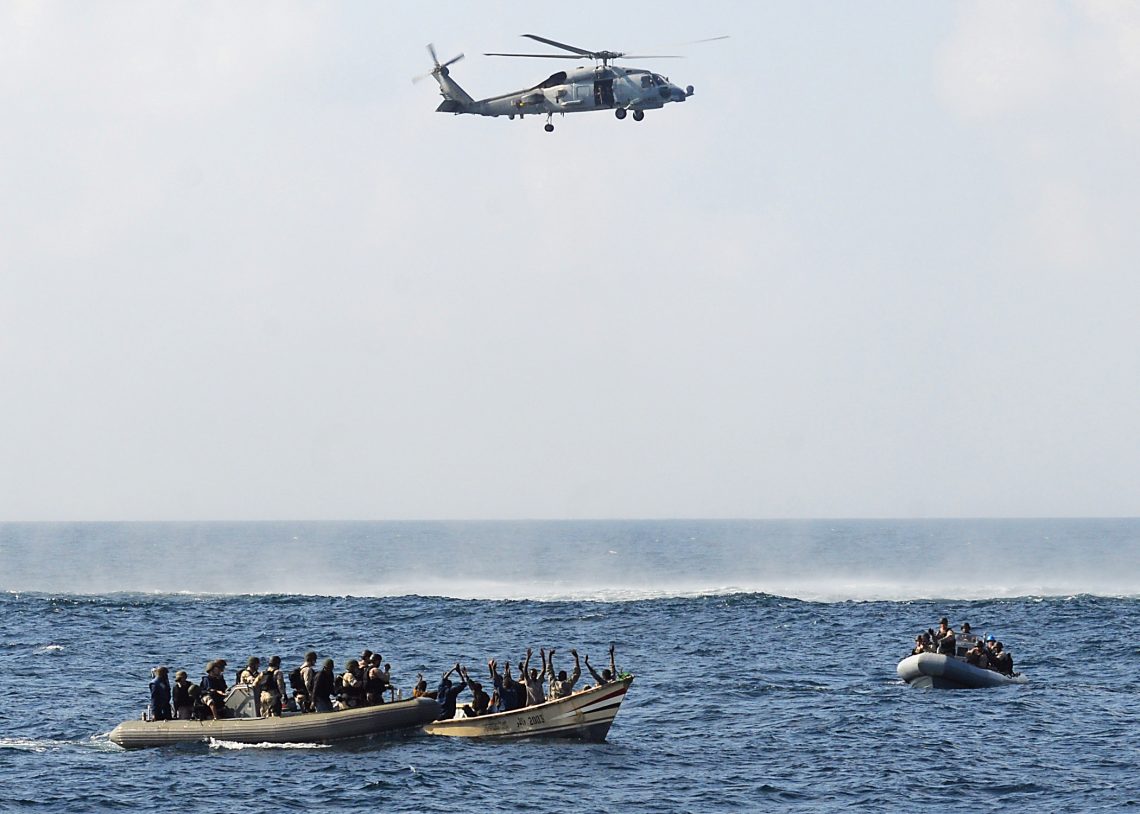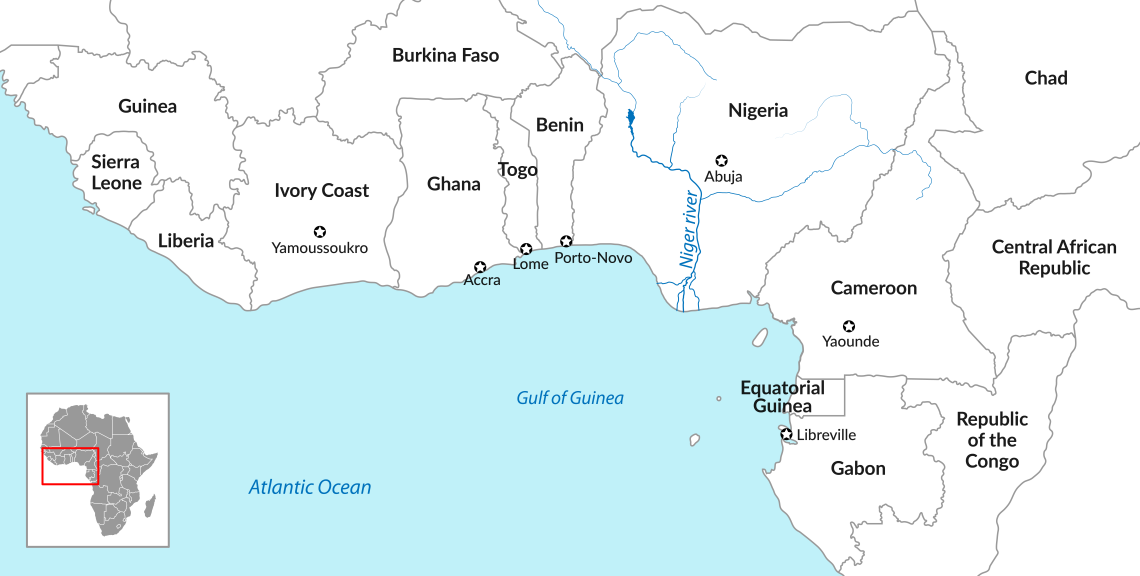Maritime piracy in the Gulf of Guinea
The rapid rise of piracy in the Gulf of Guinea poses a threat to regional security and could fuel jihadist movements coming from the inland.

In a nutshell
- The Gulf of Guinea is a linchpin of global trade
- The region has seen a sharp increase in piracy incidents
- Corrupt governments are tolerating organized crime
The coastal area surrounding the Gulf of Guinea comprises 17 countries. Nine border the gulf on the Atlantic Ocean: Benin, Cameroon, Equatorial Guinea, Ghana, Gabon, Ivory Coast, Nigeria, Togo and the archipelago of Sao Tome and Principe. Angola and the Republic of the Congo lie south, with Liberia, Sierra Leone, Guinea, Guinea-Bissau, The Gambia and Senegal to the north. The area covers 2.3 million square kilometers, with approximately 6,000 kilometers of coastline.
With a combined gross domestic product (GDP) of $866.343 billion in 2021, these countries account for almost 45 percent of sub-Saharan Africa’s GDP. Nigeria, the continent’s undisputed economic leader, and other regional powerhouses like Angola, Cameroon and Senegal, have crucial interests at play in the area. Benin, Ghana, Ivory Coast and Togo have been popping up on international investors’ radar as new business hotspots. There are vast reserves of hydrocarbons, fisheries and mineral resources in the region.
Regional cooperation is frequently hampered by political tensions and distrust between neighboring countries.
The Gulf of Guinea is also an important shipping zone for the transport of goods to and from Europe and Asia, for international fishing, and most importantly for oil and gas. The area accounts for 25 percent of African maritime traffic and is home to nearly 20 commercial seaports. It is the primary access route to and from Africa’s first and second-largest oil producers: Nigeria and Angola. Accounting for two-thirds of Africa’s oil production, the region holds 4.5 percent of the world’s proven oil reserves and 2.7 percent of proven natural gas reserves.
About 30 percent of American oil imports go through this region. France, Italy, the United Kingdom and the Netherlands are others involved in oil and gas exploration.
Red flags, threats and attacks
Over the last 15 years, the region has also become one of the world’s hotspots for maritime piracy, overtaking the Gulf of Aden and the Horn of Africa, where Somali pirates operated. But as the situation improved on the east coast, a shift occurred and piracy in the Gulf of Guinea increased rapidly. Armed attacks, vessel boarding and hijacking, kidnappings and assassination of crew members became increasingly frequent.
In 2020, out of the 135 maritime kidnappings worldwide, 130 took place in the Gulf of Guinea, the highest number ever registered in the region. A previous high was reached in 2019, when 121 seafarers were abducted. In the first four months of 2021 alone, there were 40 kidnapped crew incidents worldwide, all in the Gulf of Guinea. Adding to these other types of attacks, last year the region accounted for nearly half (43 percent) of all reported piracy incidents in the world and 95 percent of kidnapping cases.
Facts & figures
The Gulf of Guinea

Pirates’ modus operandi is also evolving. The danger is no longer restricted to territorial waters. Initially stealing cargos and siphoning fuel closer to shore, criminals have become better equipped to attack many kilometers away from the coast. The furthest attack registered in 2021 took place more than 390 kilometers south of Cotonou, the economic center of Benin, where 15 crew members of a Maltese chemical tanker were abducted. Skiffs and raiding ships with armed individuals tend to target better-equipped vessels – particularly fishing vessels – that are hijacked for later use to facilitate more sophisticated attacks. Seafarers are often injured or killed during those assaults.
Maritime shipping corporations crossing the Gulf, international organizations and several other stakeholders have been alerting to the seriousness of the situation. They warn sea lines, vessels and crews, and call for action if international supply chains crucial to the global economy are to keep flowing.
Regional and international cooperation: crucial but insufficient
In face of rising crime and insecurity at sea, African countries engaged in security-building regional cooperation efforts, which culminated with the Yaounde maritime security architecture. The framework was created in 2013 after a special conference between the Economic Community of West African States (ECOWAS), the Economic Community of Central African States (ECCAS) and the Gulf of Guinea Commission. Several multinational centers have been set up regionwide for cooperation, information and intelligence sharing.
The United Nations, the G7++ Friends of the Gulf of Guinea, INTERPOL and the European Union also stepped in. The EU imports 13 percent of its total oil consumption from the region and has contributed special support to the Yaounde Architecture – setting up strategies, action plans, programs and projects all together valued at more than 92 million euros.
France has had a permanent presence in the Gulf since the 1990s. In the early 2010s, when piracy levels started to ramp up, several countries stepped forward with their navies in missions ranging from maritime patrol and anti-piracy operations to capacity building and training, as well as providing ships and equipment to coastal states to tackle the growing threat. Whether to protect the investments of their oil and fishing companies or for political or historical reasons, Belgium, France, Italy, Portugal, Spain, the UK and the United States were all involved.
A cut in imports of Russian oil and gas could benefit the Gulf of Guinea’s oil producers, and would make the region’s maritime security agenda even more relevant.
The security situation has improved, as shown by the decline in maritime incidents over the last few years. But the problem has not been solved, only contained. Moreover, the restrictions imposed during the pandemic, which took their toll on the international maritime movement of goods – which accounts for around 90 percent of total trade – are likely to have contributed to this decline. But as restrictions are lifted and international trade and maritime movements bounce back, a return to the status quo ante is also expected.
Naval and maritime operations are crucial but do not suffice. A more comprehensive and multilayered approach is needed, aimed at both military and civilian actors involved in maritime and overall governance.
So far, this has been above all an organized crime problem. As such, being able to investigate and effectively prosecute criminal networks is key to guarantee sea lines are safe. But the Yaounde Architecture still lacks an appropriate legislative and judicial framework, without which enforcing the rule of law in the Gulf is nearly impossible.
Regional cooperation is frequently hampered by political tensions and distrust between neighboring countries. Just between ECOWAS and ECCAS, the Yaounde agreement includes 25 states with their own political and economic agendas and regional aspirations, several of them with long and deep-rooted differences and grievances. While the Gulf of Guinea countries agreed to a multinational maritime security framework, it is unlikely for some of them to tolerate outside naval intervention in their territorial waters. Regional leadership, political engagement and continued cooperation will be necessary to deliver results. But sovereignty concerns and political and economic competition could hinder such goals.
Scenarios
Piracy and other illicit maritime activities are deeply intertwined with weak governance. Although there are differences from state to state, overall, the region is still plagued by corruption: security services, border control, customs and many others in key positions all benefit from transnational organized crime. Misappropriation of development funds provided by international partners is also part of the equation.
Unlike maritime piracy off the Horn of Africa, the problem in the Gulf of Guinea is not related to state collapse, but rather the result of states that tolerate illicit behavior in a “complex criminal web” encompassing “foreign oil traders, shippers, bankers, refiners, high-level politicians and military officials,” as described by a Chatham House report.
Economic outlook
The regional black market for oil (itself a product of structural problems within West African states) is one of the main drivers of piracy in the Gulf of Guinea. In Nigeria, oil accounts for 75 percent of state revenues and 90 percent of its exports. But fuel and oil theft and smuggling result in an estimated loss of 6 to 10 percent of the country’s output.
A possible cut in imports of Russian oil and gas, given the current conflict in Eastern Europe, could benefit the Gulf of Guinea’s oil producers, and would make the region’s maritime security agenda even more relevant.
With one of the world’s richest fishing grounds, the Gulf accounts for almost 4 percent of global production. But adding to the 65 percent of legally reported catch (the highest level in the world), illegal fishing is estimated to cost $1.5 billion to local governments and further escalates economic tensions and risks. Employing millions of people, these key sectors for regional economic growth could be endangered if piracy levels and illegal trade spiral out of control.
With a growth average of around 4 percent from 2010 to 2019, some of the 17 countries of the coastal region are performing well, with growth rates over 6 percent. Profits, however, do not necessarily trickle down to the masses given the misappropriation of natural resources revenues. The region is home to some 417.6 million people, and is expected to account for 25 percent of the global population by 2050. Unemployment is high, especially among the youth. Faced with a lack of economic opportunities, young people are likely to look for other sources of income, facilitating recruitment by criminal groups. The current picture does not bode well for the region’s economic and social prospects.
Governance
Long-term reforms addressing the multidimensional structural problems behind maritime crime – weak political institutions, corruption, resource control-led conflicts, demographic pressure – are needed to tackle the issue. However, they are unlikely in the near future, especially since there are reasons to question governments’ commitment and political will to undertake these reforms.
Destabilization
Rampant levels of maritime insecurity, transnational organized crime, smuggling and trafficking (also linked to drugs coming from South America) and illegal fishing, could compromise the economic prospects of the region, threatening maritime trade in the short term, and in the longer run the stability of coastal states. Political instability in Guinea-Bissau is already a reflection of this trend.
While the Gulf of Guinea may not be at the top of the international agenda, it remains a strategic area. Instability could be made worse by the region’s proximity to the Sahel. With direct and porous land borders with Mali and Burkina Faso, the risk of destabilization throughout West Africa all the way to the coast should be considered.







